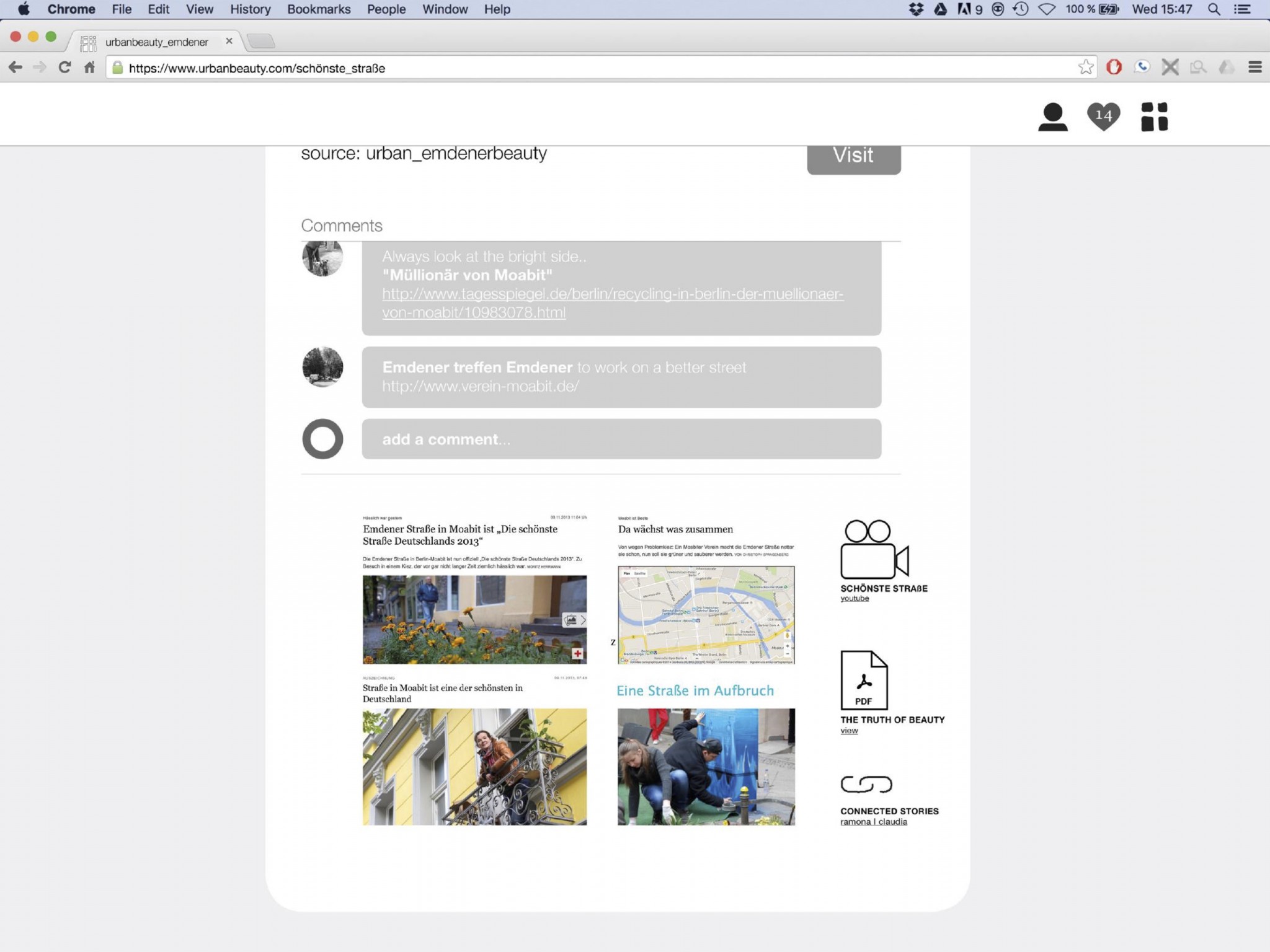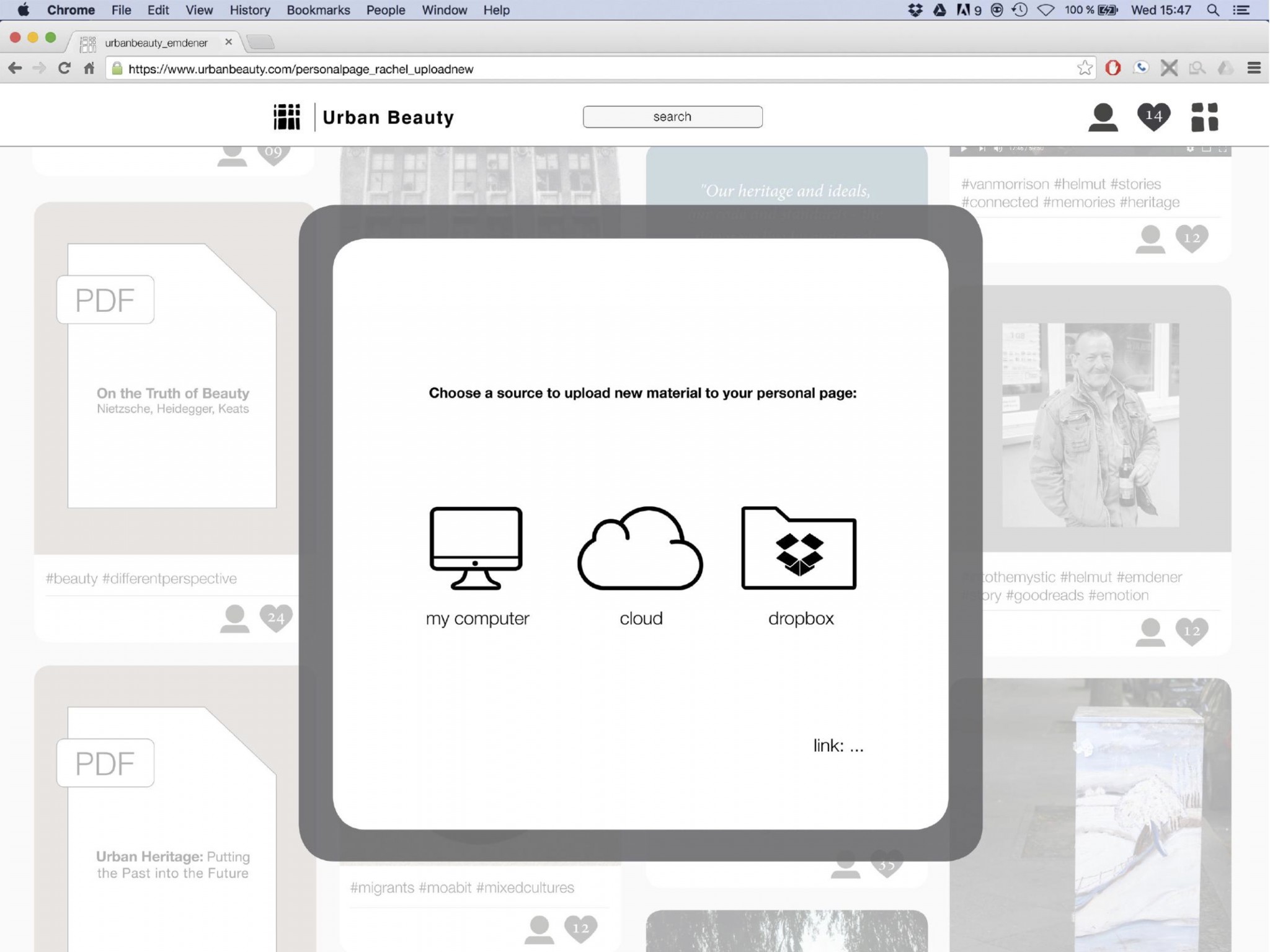URBAN BEAUTY (2016) – Benjamin Herfurth, Maryam Poursafar, Pommeline Warringa
RESEARCH STATEMENT
The first steps
We were assigned to start our research in the area around Emdener Street (Moabit,Berlin). Visiting this street, aware of the fact that it has been rewarded as “the most beautiful street of Germany” in 2013, placed our first observations in a whole new perspective. Why has precisely this street won the award? What were the criteria? Who was involved? Who decided? And most of all, how do the inhabitants perceive their street? Did their environment change the past few years? How?
Heritage from Below
The idea was to first explore the “beauty” of Emdener Street. Without interruption or any further research, we decided to get a better impression of the environment by doing a couple of visits on site and talking to locals. We continued our research by contacting the “Verein Moabit e.V.” (together with it’s suborganization “Emdener treffen Emdener e.V.” and Mr. Schreiterer – the initiator and ex-inhabitant of the Emdener Straße) to learn about the process of selecting this particular street as a winner of “Germany most beautiful street 2013”.
Unfortunately this path turned out to be a dead end, we didn’t receive any response. Homepages of both organisations are outdated, but this was actually useful information that raised new questions. Are these “outdated” websites a direct reflection of the actual state of the Emdener Street? How do the Emdener perceive “change” in their street?
Asking the inhabitants about the project “most beautiful street of Germany” seemed at first to be a springboard to get in contact more easily with the citizens of Moabit – the Emdener in specific.
Central questions and considerations
Quickly we realized that we had to nourish our on-site findings with an external research. Anteriorly to our first interviews, we were optimistic about the ease of collecting data in the street, as well as the willingness of the inhabitants to collaborate on our research project. We decided to conduct interviews by strolling up and down the Emdener Street, narrowing our focus on this particular piece of Moabit. In order to question the topic “change”, we targeted the visible changes within the street. Using the physical environment of the inhabitants, helped us introducing the actual topic of “urban beauty” to the public in an understandable way.
During the first few interview sessions it was easy to find people willing to participate. We recorded, took photos (of course depending on their permission) and talked about the award. It was interesting to hear all these different voices and see how the street reunites such a vibrant variety of opinions. Especially interested in the beautification of the Emdener Street, we asked their opinion about the “beauty” of the street and what “beauty” means in an urban context.
We introduced a second method. Armed with questionnaire and business card (with e-mail address), it was nearly impossible to talk to inhabitants. Our initial idea was to give them the opportunity to be creative. After three main questions, there was a little box on the bottom where one could draw or write. We thought this was a good way to give some space to interpretation. In reality, the majority of the people refused to fill this last box.
We also wanted to have the children of the street to participate in our project. The idea was to create a collective artwork from different kinds of drawings or quotations. We collected only a few drawings from children and were highly surprised by the sceptical behavior of the Emdener.
After the midterm-presentation we focused on a simpler version of a questionnaire. Even simple questions didn’t work out. In the meantime we collected a few interesting stories, most of them derived from conducted interviews without questionaire or precise questions.. On the strength of this we decided to concentrate on the artistic side of our stories for a while. We began including our research as background information for the narratives we collected, linking descriptions and experiences with theoretical information and historical facts.
Looking at our research material in a different way, helped us reflecting on the actual outcome of our project. We got more than we actually thought. Not only did we get information about the physical beauty of the street and the urban environment in general, but also, and maybe even more important, an impression of the emotions of the Emdener. We got to experience little pieces of daily lives, an insight view of dealing with the fast mutating environment of Moabit.
We see ourselves as flâneurs – away from home and yet feeling at home in the Emdener environment that we experience throughout the stories of it’s inhabitants..
Fifteen narratives encode, store, retain and recall information and past experiences from the Emdener – a collection that expresses emotions and feelings.
Inspiration from lectures and readings
The texts “My Atlas“ by Vilém Flusser and „Wandering in the city“ by Christel Hollevoet. Prof. Dr. Marian Durk was a big source of inspiration regarding the development of our online platform. He showed us examples of archiving narratives and other information.
Conclusion
We have learnt to not set preliminary conditions such as a questionnaire to a research project. The demanded information should be simple so that the interviewee feels at ease to talk freely. “Expecting the unexpected” is a dictum for the project. We expected a more visible diversity of the outcome of the interviews in Dar es Salaam and Berlin. This wasn’t the case.
Creating a homepage was an interesting exercice in order to reorganize our research and narratives. Most of the successful pages on the net follow the same scheme: the KISS principle. They are simple and accessible. It’s the paradox of choice (Barry Schwartz) we wanted to eliminate.










